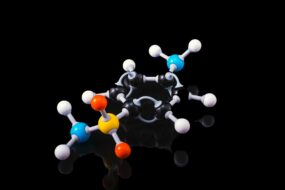- Home
- DRUGS
- Respiratory system
- Theophylline
Theophylline is a methylxanthine derivative with a narrow therapeutic index.
Has phosphodiesterase inhibiting activity in the body.
It is well absorbed orally and distributed in all tissues.
Mechanisms of action.
- Inhibition of phosphodiesterase activity hence relaxation of bronchial smooth muscles.
- Inhibits synthesis and secretion of inflammatory mediators from mast cells and basophils.
- A competitive antagonist of adenosine thus binds to adenosine receptors and blocks adenosine-mediated bronchodilation.
Clinical uses.
- Bronchial asthma and COPD by causing bronchodilation.
- Apnoea in premature infants.
- Chronic bronchitis and emphysema.
Adverse effects.
- Theophylline has a narrow margin of safety and hence has dose-dependent toxicity.
- CNS: Headache, insomnia, restlessness, and seizure.
- CVS: palpitations,hypotension,ventricular tachycardia,cardiac arrest.
- GIT: GI disturbance and protenuria.
- Alopecia,metallic taste and diuresis.
Contraindication.
- Hypersensitivity reaction to any xanthine.
- Peptic ulcers
- Epilepsy.
Drug Interactions
- Agents which enhance theophylline metabolism primarily by inducing CYP1A2 to lower its plasma level; hence the dose has to be increased, i.e., Smoking, phenytoin, rifampicin, phenobarbitone.
- Drugs that increase its plasma levels include; thiabendazole, erythromycin, and isoniazid.












